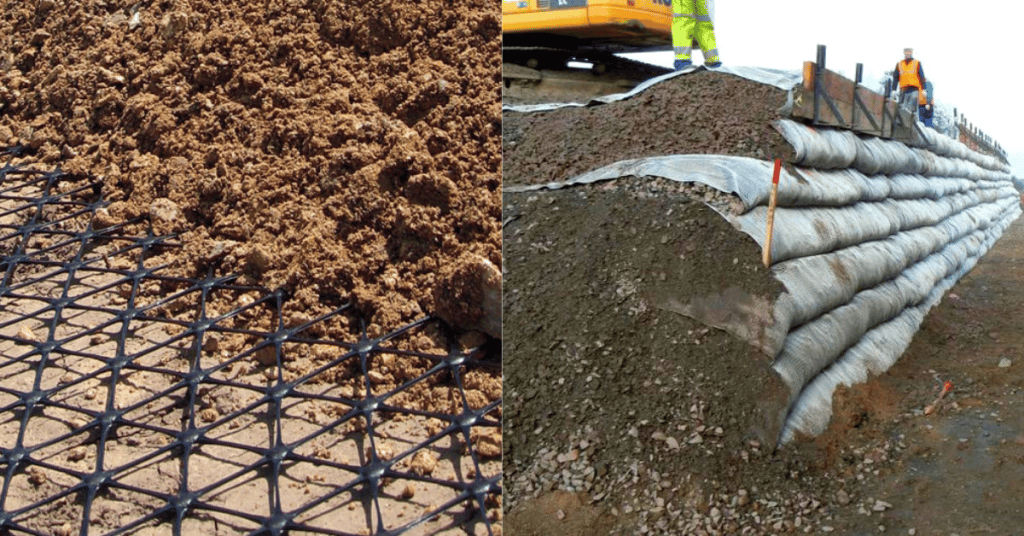Geogrid Vs Geotextile: What are the Differences?
Geosynthetics originate from the words Geo = “soil or earth” and Synthetics which means “man-made”. They are man-made materials made from plastics.
These petrochemical-based polymers do not initiate a response or interact when introduced to biological tissue. One notable characteristic of geosynthetics is that they will not decompose from fungal or bacterial actions, which is why they are used to improve soil conditions.

There are different types of geosynthetic materials. The types used in agricultural applications can be divided into these categories:
- geogrids
- geotextiles
- geocells
- geomembranes
- erosion control
In this article, we will compare Geogrid vs Geotextile, noting the differences. Many hardscape DIY-ers find it difficult to be sure which material to use. In this article, you can learn the differences.
What is Geogrid?
These are open mesh-like materials of integrally connected polymers. Geogrid is made from polyester, polyethylene, or polypropylene.
They are primarily used for soil or hardscape reinforcement and stabilization; for instance, reinforcing a retaining wall backfill in several civil engineering-related applications.
In most cases, geogrids are used in high-demand agricultural or heavy load situations. As a result, their strength can be greater than most geotextiles.
Thanks to its low strain, geogrids are strong in tension, stretching only about 2 to 5% under load. Geogrids come in three types, namely, extruded geogrid, woven geogrid, and bonded geogrid.
a. Extruded Geogrids
These are manufactured by stretching uniaxially or biaxially extruding polymers or extruded integral structure.
Extruded geogrids are generally rigid when compared to flexible woven and bonded geogrids.
b. Woven Geogrids
These are produced by weaving together polypropylene coated polyester fibres into longitudinal & transverse ribs.
After which, knitting or intertwining is introduced to join the crossovers before protecting the entire unit with an additional coating.
c. Bonded Geogrids
As the name implies, bonded geogrids are manufactured by bonding two or more sets of strands or other elements, typically a right-angles.
What is Geotextile?
Geotextiles are defined as any permeable textile used for dirt, soil, earth, or rock in any geotechnical engineering-related project or structure or system.
It is the most widely-used geosynthetic material for agricultural purposes. Geotextiles come in rolls up to 18 ft (5.6m) wide and 160 to 500 ft (50 to 150m) long.
They exist as geo fabric and filter fabric. These two textiles are permeable fabric made of polyester or polypropylene that are classified into two forms based on the method used to place the yarns or threads in the material: either woven or non-woven.
a. Woven Geotextile
These are cloth-like fabrics formed by the uniform and regular interweaving of yarns or threads in two directions. Woven geotextiles have a regular visible construction pattern as well as distinct and measurable openings.
They have a low strain, limited elongation under load – typically up to 15% – with high tensile strength. These exceptional features make them applicable for soil separation, load distribution, drainage, reinforcement, and filtration.
b. Non-woven Geotextile
These are felt-like fabrics that do not have any visible pattern. Non-woven geotextiles are formed by placing threads in a mat, randomly bonded by needle punching, heat-bonding, or resin-bonding.
Unlike woven geotextiles, non-woven has a relatively high strain and stretch considerably under load (about 50%).
As a result, they are used for drainage, load distribution, soil separation, and stabilization – but not for soil reinforcement, such as in retaining walls.
Geotextile separation applications include:
- Flexible or unsurfaced pavements for vehicle and truck traffic
- Construction site access routes and working platforms
- Sludge pond caps or industrial waste lagoon
- Railway alignments
- Container storage yards
- Flexible or rigid airfield pavements
- Moderate height embankments and fill pads
Differences Between Geogrids and Geotextiles
- Geotextiles are manufactured for separation, filtration, and drainage purposes, whereas geogrids are specifically manufactured as a reinforcement material.
- A geogrid is unlikely to separate any type of fill. For instance, once the subgrade soils become saturated, it can easily flow through the geogrid apertures. However, the geotextile can allow the free movement of water from the soil into the aggregate layer, and vice versa.
- In general, it may seem that geogrids’ interlocking of the soil with the grid membrane makes it a superior form of reinforcement; however, the geotextile provides the separation function that ensures it maintains its thickness, service life, and long-term strength.
- Geogrids are passive resistance dependent reinforcement, whereas geotextiles are frictional resistance dependent reinforcement.
- Geotextile installation involves:
- Grading
- Evacuating
- Allowing vegetation, and
- Placing the separation geotextile directly on the prepared subgrade
Geogrid installation involves:
- Planning the geogrid retaining wall
- Evacuating
- Sub-base and base stabilization
- Gravel levelling
- Laying retaining wall blocks
In a Nutshell
So here you go, the difference between geogrid and geotextile. For more information regarding the installation of geosynthetic products in civil engineering and the construction industry, please feel free to get in touch with our specialists.
